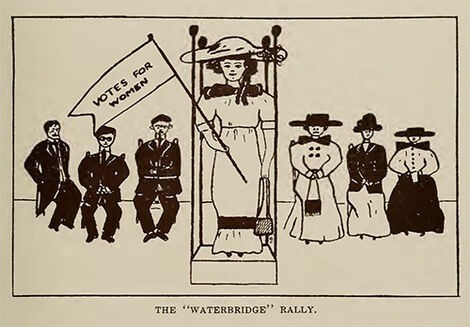
There has been a great deal of discussion in recent months about a significant increase in women registering to vote in the upcoming national elections in November. In large part because of the Supreme Court decision to strike down the Roe v. Wade abortion rights policy and state legislatures quickly implementing laws to limit if not end a women’s right to an abortion, women are now poised to have an impact on who gets to represent them in the House of Representatives and the Senate. It is important, however, to stress that women and voting has not been a simple and easy process in our country. Women have struggled to gain their right to cast ballots and have their voice heard in the political arena. Let’s take a look at this struggle for women and voting, often termed suffrage.
The story of women and voting rights starts in 1848 when the first women’s rights convention was held in Seneca Falls, New York under the leadership of Elizabeth Cady Stanton. At the convention the participants passed a Declaration of Sentiments that demanded women be given a list of rights including the right to suffrage. Later Elizabeth Cady Stanton became the first woman to run for a seat in the U.S. House of Representatives, despite the fact that she was unable to vote or have other women vote for her. She received 24 votes out of 12,000 votes cast.
In 1872 another suffrage activist, Susan B. Anthony cast a vote for president, which was illegal. She was promptly arrested and put on trial. She was found guilty and fined $100, a sum she refused to pay. As she said at the time: “…we propose to fight our battle for the ballot — all peaceably, but nevertheless persistently through to complete triumph, when all United States citizens shall be recognized as equals before the law.”
Through the efforts of Elizabeth Cady Stanton and Susan B. Anthony women became active in efforts to gain the vote and win public office. In 1872 Victoria Woodhall ran for President on the Equal Rights Party ticket. She was followed by Belva Lockwood, who in 1884 and 1888 also ran for President. In 1887 Susanna Salter of Argonia, Kansas became the first female mayor in the United States, while in North Dakota Laura Eisenhuth was elected superintendent of public instruction, the first woman in the United States to rise to statewide executive office.
Also, in one of the the most significant developments in the struggle to break down the barriers to full and equal participation, Jeannette Rankin of Montana became the first female elected to the U.S. Congress. Montana was one of the first states to allow women to run for national office. Rankin served from 1917-1919 and again from 1941-1942. A dedicated pacifist, Rankin cast the only no vote against the U.S. entry into World War I and II.
Finally, after years of struggle to overcome resistance to women’s suffrage the 19th Amendment to the Constitution was passed in 1920, which gave women the right to vote. As the Amendment stated: “The right of the citizens of the United States to vote shall not be denied or abridged by the United States or by any State on account of sex.”
Although the Amendment provided new opportunities for women in politics and government, many women continued to face bias and roadblocks to their involvement in holding high public office. It was not until 1981 that Sandra Day O’Connor became the first woman to serve on the U.S. Supreme Court, followed by Madeline Albright who became the first woman to be named Secretary of State in 1997 and Nancy Pelosi, who became Speaker of the House of Representatives in 2007. And in 2020, 100 years after the passage of the 19th Amendment, Kamala Harris became the first woman to be elected Vice-President of the United States. There is now only one more barrier left to cross for women in politics — the Presidency of the United States.
Today, women are increasingly playing a major role in the government of the United States at all levels of public responsibility. Gaining the vote was a struggle, but a struggle that has changed the character and quality of our democracy.